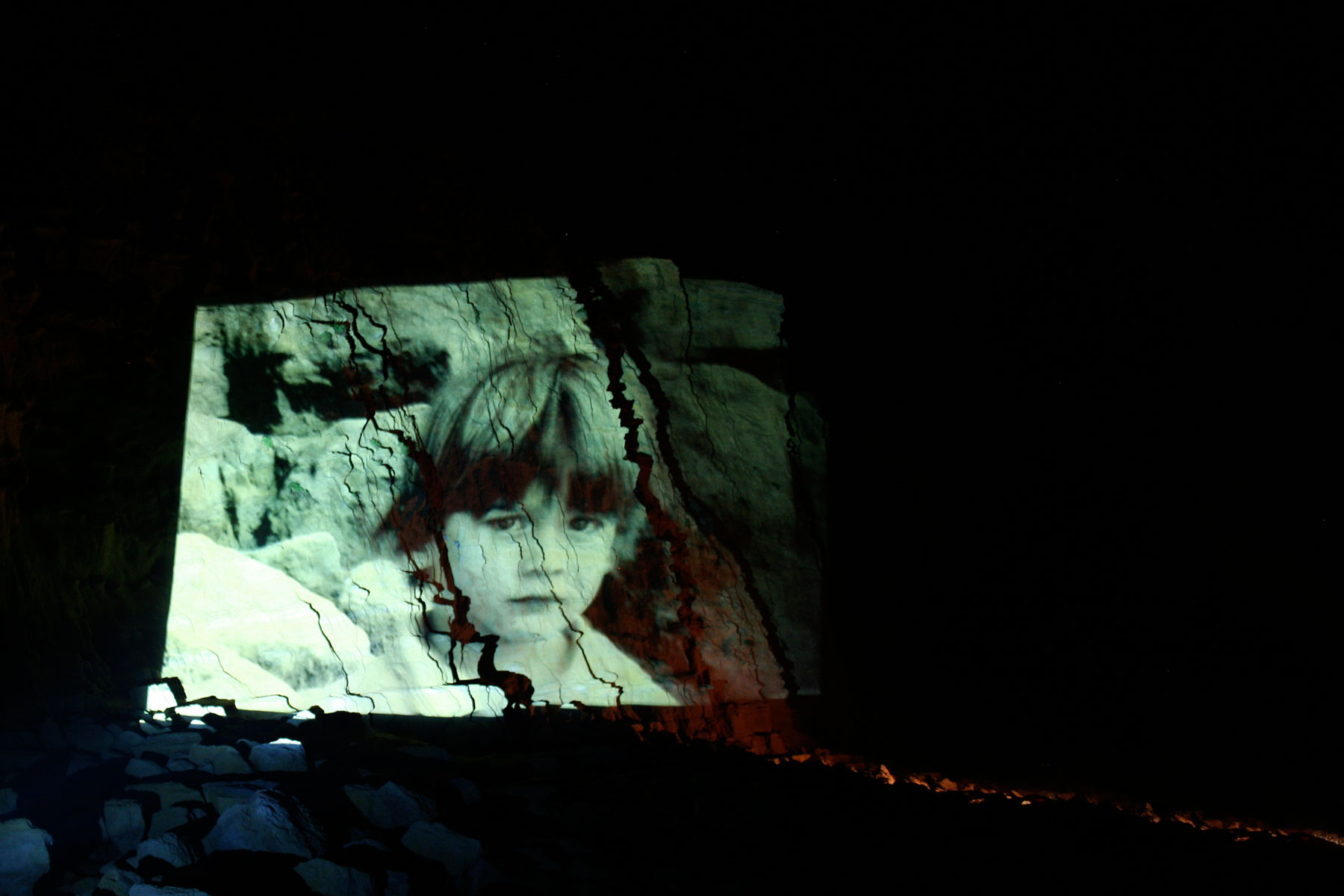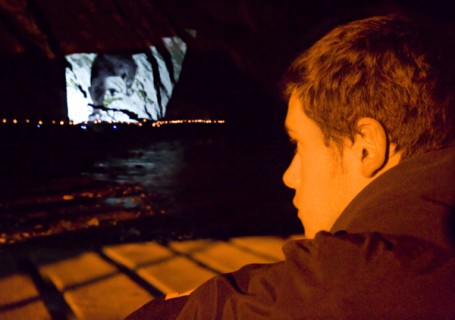Deep Time


A series of three site-specific performances commissioned by PVA Medialab and the Jurassic Coast World Heritage Site.
The performances took between September 2008 and September 2009.
The title Deep Time comes from a term used to describe geologic time and the evolutionary changes that are documented in layers of rock and deposited over 4.6 billion years.
The three events form a trilogy exploring different aspects of human connections to the process of evolution, drawing attention to the land as a record of everything that has passed, and to human relationships to the landscape now.
The project explores metaphors between the layers and layers of time, the shifting of land-masses and of our fleeting live and shifting presence on the earth.
Part One Origin of the Species. Sunday 28th September. West Bay Cliffs after dark (8.30pm).
Working with the West Bay Cliffs as backdrop, stage and cinema screen, this site-specific performance draws peoples attention to the significance of the site as an ancestor. It points out that this place on which we walk is made of everything that has gone before us and is an ever-changing record of the process of evolution.
Part Two
Here Now
Budleigh Salterton After dark/at sunset These pieces offer a different lens through which to view the landscape. They also offer a context for reflection – a moment in which to consider our relationship to places which so define our history and whose future is so entwined with our own.
What does this place mean to us? What is universal value in relation to sites such as these? What might drive us to want to protect this?
This piece is a development of the first one which was meditation on the simple fact of our connection to, and origins within the landscape. The second piece develops some of the same elements and ideas, but also introduces a live performance element to the piece.
I will use the film created for the first piece re edit it whilst creating another film with people from the local area. The two films would be projected simultaneously and would interact with each other. The live element of the piece serves to engage people in the human scale of things – in the here and now aspect of being in the landscape.
The live performance will consist of a simple set of movements learned by people either in workshops or onsite on the day. The contrast between the hugeness of the landscape and of the images projected onto it will serve to remind of a sense of scale – the hugeness of time versus the smallness of us – how short a time we have and what will we choose to do with it?
I will work with people of all ages to explore ideas of scale – the vastness of the landscape with the smallness of the human presence as a metaphor for the vastness of geologic time set against the very short time that humans have been present on the planet. Our need to protect and conserve the landscape is really about conserving ourselves more than it is about conserving the planet – we conserve something about our humanity by conserving the environment that hosts us. These cliffs house the remains of species that lived far longer than we have and those species are long gone – their remains recorded inlayers of rock. We will become dust. But we are here now. Impossible beauty, impossible pain – the pain and beauty of our existence. Our lives cannot be considered as separate from the planet – we come from it and return to it – Indeed we barely leave it – we’re a bunch of Mayflies born and dying in one short day – barely here – all the more so because we barely notice that we are here. We race through our lives not taking time to see where we are – to see what it is. Here it is, here we are, here – now. This piece – Here Now comments on the fact that our presence is inconceivably brief in the scale of geologic time.. What is the significance of this short time – our time as visitors to this planet – guests watched over indifferently by the land. The piece will involve projecting a film – created in the same way as the first one by filming people on the beach at Budleigh. Those people will also be encouraged to participate in the performance by learning a sequence of movements on the day. Full instructions will be available about where to be and what the piece is about. This live aspect of the piece reminds us of something about scale – the smallness of us and the bigness of the cliffs, the newness of us against the oldness of the land. The transience of us projected fleetingly onto the cliffs.
Part Three
Without Us
Lulworth Cove. Nightime.
The title comes from the book written by American journalist Alan Weisman: The World Without Us, about what would happen to the natural and built environment if humans suddenly disappeared. The final event of this triptych is a performance created with 100 people or more. The piece is learned by people through a video posted online on the YouTube website. The video teaches people a sequence of movements performed to a piece of music. The participants sign up online to take part. They learn the movement and show up on the site on the day for a rehearsal and then perform the piece. It almost has a sense of a show of hands – the piece is a kind of homage to the landscape, and the performers form a sort of field of people – a living and transient monument to a moment in time. The piece is as much about the landscape in which it takes place as it is about the people. It offers a different lens through which to see the site and is a contemplative and quietly joyous celebration of our place on the earth. Our connection to the past and present of this place The title is intended to be considered in watching the piece and it really is the culmination of these events – the final piece which acts as a receptacle for the consideration of a massive question – what is our place on this earth? Will the earth miss us when we are gone? “Without us, Earth will abide and endure; without her, however, we could not even be.” Alan Weisman. The World Without Us. Sundown at East Cliff, West Bay. September 28 2008. Charlie Morrissey’s stunning new work for the Universal Value commission was revealed to an audience entranced by the monumentality of the landscape and lulled to silence by the sound of the sea. Audience responses to Origin of The Species included – ‘A serene and contemplative work set against the magnificent backdrop of East Cliff. As the projected faces passed by, acutely detailed and sensitively observed, one was filled with a feeling of time and generation, and even of timelessness itself. Inter-cut with images of the foreshore and sea, often, and quite disruptively, delivered in reverse motion, the entire drama played out with great poignancy. However, other factors were at play. The surface of East Cliff, grand, vertical and deeply fissured, imbued a sense of optical dissonance, disturbing the otherwise poetic progression of images. Faces were scared and distorted; young skin rendered arid with smiles and features cracked by the eroded surface. East Cliff fused as one with the images and transformed them all with a dark and gently sinister undertow of impermanence. Every thing changes – everything ages, even the eternal cliff face. Initially gentle imagery was transformed with a gravitas that reflects the observational skills and sensitivity of the work’s creator.’ ‘Amazing, a very touching display of innocence and humanism.’ ‘Simple, elegiac, beautiful. A melancholic summer’s last kiss. Intimacy on a grand scale.’ ‘The West Bay event on Sunday night was truly wonderful. As a Jurassic Coast event it was fantastic – the subject matter of local people, it was about and completely harmonious with the coastal site but also monumental and wonderful in its scale. The simplicity of the projection accompanied by the sound of the sea, the lanterns on the beach and the flaming torches along under the cliff made the event really magical and as someone local to that particular bit of the coast I felt overwhelmingly privileged to live somewhere so beautiful. Walking away from the site and watching the second ‘viewing’ from the East pier was for me the real revelation with the image distorted to the full height of the cliff and reflected in the sea – I’d love to know if there were any fishermen watching from the sea! I felt that I really was experiencing the place in a completely new way – so the pre-requisites of site specific work were genuinely met for me.’ ‘Beautiful, sensitive, moving and evocative. I can’t wait to see the next two parts of the trilogy.’